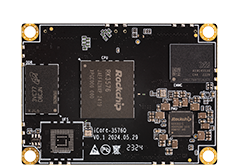6. LED¶
6.1. Introduction¶
There are 2 LEDs on the AIO-3576Q development board, as the following table shows:
| LED | Pin name | Pin number |
|---|---|---|
| Yellow | GPIO3_A2 | 98 |
| Green | GPIO3_A3 | 99 |
LEDs can be controlled by using the LED device subsystem or by directly operating GPIO.
6.2. Controlling LEDs by device¶
Linux has its own LED subsystem for LED devices. In iCore-3576Q, LEDs are configured as LED class devices.You can control them via /sys/class/leds/.
The default status of the three on-board leds are:
Yellow: Turn on after the system powers on
Green: defined by user
You can change the behavior of each LED by using the echo command to write command to its brightness property:
echo 0 >/sys/class/leds/:diy/brightness // led off
echo 255 >/sys/class/leds/:diy/brightness // led on
6.3. Using trigger control LED¶
Trigger contains a variety of ways to control the LED, here with two examples to illustrate.
Simple trigger LED
Complex trigger LED
For more information, please read the document leds-class.txt.
First of all, we need to know how many LED definition, while the corresponding property of the LED is.
Defined LED node in file kernel/arch/arm64/boot/dts/rockchip/rk3576-firefly-aio-3576q.dtsi, like this:
#if LED_GPIO_OR_PWM
firefly_leds: leds {
compatible = "pwm-leds";
status = "okay";
power_led {
label = ":power";
pwms = <&pwm2_8ch_0 0 50000 0>; //blue
max-brightness = <255>;
default-state = "on";
linux,default-trigger = "ir_led";
};
user_led {
label = ":user";
pwms = <&pwm2_8ch_2 0 50000 0>; //red
max-brightness = <255>;
default-state = "off";
linux,default-trigger = "none";
};
diy_led {
label = ":diy";
pwms = <&pwm2_8ch_1 0 50000 0>; //green
max-brightness = <255>;
default-state = "off";
linux,default-trigger = "none";
};
};
#else
firefly_leds: leds {
compatible = "gpio-leds";
status = "okay";
power_led: power {
label = ":power"; //blue led
linux,default-trigger = "ir-power-click";
default-state = "on";
gpios = <&gpio2 RK_PD0 GPIO_ACTIVE_HIGH>;
pinctrl-names = "default";
pinctrl-0 = <&led_power>;
};
user_led: user {
label = ":user"; //red led
linux,default-trigger = "ir-user-click";
default-state = "off";
gpios = <&gpio2 RK_PD2 GPIO_ACTIVE_HIGH>;
pinctrl-names = "default";
pinctrl-0 = <&led_user>;
};
diy_led: diy {
label = ":diy"; //green led
linux,default-trigger = "ir-user-click";
default-state = "off";
gpios = <&gpio2 RK_PD1 GPIO_ACTIVE_HIGH>;
pinctrl-names = "default";
pinctrl-0 = <&led_diy>;
};
};
#endif
Note: The value of compatible must match the one in drivers/leds/leds-gpio.c.
6.3.1. Simple trigger LED¶
It is a simple trigger mode to control LEDs, please refer to kernel/drivers/leds/trigger/led-firefly-demo.c
6.3.2. Complex trigger LED¶
The following is the trigger mode control LED complex example, timer trigger is to let the LED to achieve constant on/off effect.
We need to configure the timer trigger on the kernel.
In the kernel-5.10 path using make menuconfig, in accordance with the following method to chose timer trigger driver.
Device Drivers
--->LED Support
--->LED Trigger support
--->LED Timer Trigger
LED Timer Trigger should be enabled by default. If not, enable it, save defconfig and re-build kernel to take effect.
Echo “timer” to trigger then we can see LED starts to blink.
echo "timer" > /sys/class/leds/:user/trigger
The user can also use the cat command to get the available values for the trigger:
# cat /sys/class/leds/:user/trigger
none ir-power-click rfkill-any rfkill-none test_ac-online test_battery-charging-or-full
test_battery-charging test_battery-full test_battery-charging-blink-full-solid
test_usb-online mmc0 [timer] heartbeat backlight default-on ir-user-click mmc1
rfkill0 tcpm-source-psy-6-0022-online rfkill1 rfkill2
